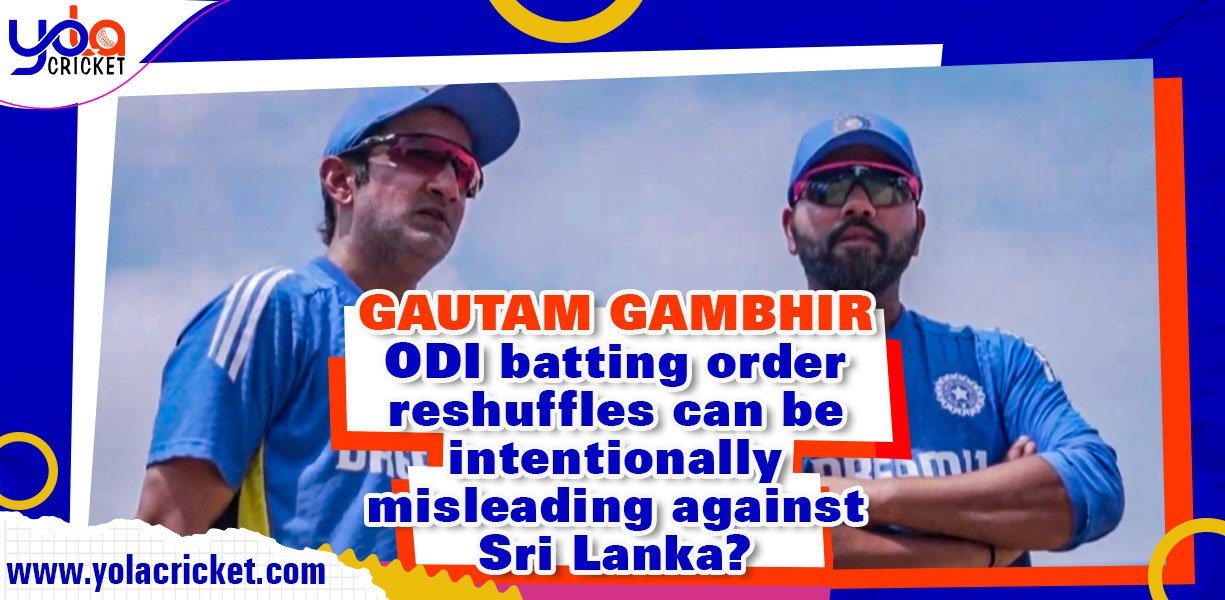
Gautam Gambhir’s criticism set out to address some serious issues that have mired the team, just like the sentiments of the former leaders Rahul Dravid and Ravi Shastri, as the cricketing powerhouse of India comes under scrutiny, all over again. You will witness this pattern of batting collapsing, especially against spin, repeating over and over, leaving India no chance to come victorious in some of the most critical knockouts. Through this blog, Gambhir tries to make sense of it all, and maybe even hint at some changes required to bring a new result to a fate that has been far too common for Indian cricket.
India’s Current Overview of the Cricket Scenario
The following section sets the context within which the challenges faced by the Indian cricket team can be analyzed at a deeper tactical level. The contemporary landscape witnesses not only the inevitable challenges modern cricket poses but also the burden of historical contexts within which the performances of such teams are measured.
Historical Context
Fluctuating fortunes, largely determined by its ability to bat against spin bowling, have been characteristic of India’s cricketing odyssey. A vaunted Indian batting lineup dating from the 1990s has more than often come a cropper against part-time spin in demanding conditions.
Current evidence establishes a disturbing trend in Indian performances against spin bowling, and that was quite evident in the recent ODI series played against Sri Lanka. The team had two big collapses, not being able to make the best use of good starts on numerous occasions, leading to an unfortunate series result for them where they almost faced defeat history.
Plus, in the last ODI series, though it started on a bright note with partnerships such as the 75-run opening pair of Rohit Sharma and Shubman Gill, India’s batting suddenly folded like a pack of cards, falling from 97 runs without loss to 147 for six in the second match(India vs Sri Lanka Highlights). With a full-strength team, the onus placed on quality spin-bowling by the opposition exposes a critical vulnerability, which an observer like you should be intensely aware of because it is a sign of the call for strategic rethinking.
The cricket landscape in India has undergone a significant change lately, bringing Gautam Gambhir’s criticism at the helm now worded with challenges that echo concerns expressed earlier by cricketing legends like Rahul Dravid and Ravi Shastri. You, on the other hand, must be a bit puzzled as you go deep inside the very core of this model of leadership and think about how Gambhir is going to pull the team out of their present losing spree, considering that batting collapses against good quality spin are virtually commonplace today. If you are curious about public opinion, here are some of the Quora responses on what people think about the appointment of Gautam Gambhir.
Transition from Previous Coaches
On assuming the new role, Gautam Gambhir’s criticism finds himself leading a side that came under a lot of scrutiny after the substantial contributions of Dravid and Shastri in the past. With the big switch from the old philosophies, you may wish to consider a functional analysis of Gambhir, his coaching style, and what new dimensions of team dynamics and problem solving in particular-but in general-issues like batting under pressure on spinning tracks.
The General Issue of Accountability in Leadership
Leadership in more than just the manager’s role in cricket; it is about accountability for enabling performance on a constant basis. One must admit that when these challenges arise, especially like India’s repeated collapse against spin, leaders need to be accountable for the failure and success.
And in a cricketer’s world, which may scrutinize performance metrics more than ever, accountability can also be a potent tool of leadership. The inability of the team to combat time-spin threats, as seen from past performances, underlines the necessity of Gambhir inculcating a culture where players feel answerable for their show. Taking learning from past criticisms and planning rooted in accountability will be crucial for Gambhir to imbibe resilience in the ambitions of his team. This is equally about being able to win, learn, and grow in adversity.
At that, the much-vaunted India batting unit seemed to be performing poorly under constant pressure from bowling on turning pitches. It is now a worrying trend, not just for fans, but also for experts and former players, with the likes of Dravid and Shastri expressing concerns over the same. As Gambhir discusses, issues raised by the likes of Dravid, Shastri, and others keep the big question in the air: how does one address this gaping hole in the performance of his team?
Recent Matches Played against Spin Teams
On a number of recent occasions, India has suffered massive collapses while batting to a prepared line-up of spin-heavy teams. In the ODI series against Sri Lanka, for example, India went from a comfortable 97 without loss to a collapse that saw them bowled out for 208(India vs Sri Lanka Highlights), a trend that repeated itself in the matches before. These performances expose the frailties of your team on turners, having seen almost the same travails in previous tournaments.
Batting Techniques: An Analysis
What drags them down quite a bit is that the technique of your players does not seem to be strong enough to deal with spin bowling. Many of your batsmen seem quite tentative, showing an inability to use their feet, which worsens the case for the spinner.
You can only evaluate the batting of your players if you watch them face spin bowlers. Overreliance on the back foot exposes the players to balls that extract sharp turning. Equally, the good use of the front foot towards the pitch of the ball nullifies the turn and ideally takes charge of the innings. Emphasize the aspects of using good footwork and predetermined shot selection against the spinners in order to avoid frequent failures under related conditions.
Gautam Gambhir’s criticism on Coaching Philosophy
Contrastingly to most of his predecessors, who had attempted to undermine the necessity of taking up spinning challenges, Gautam Gambhir comes in with, relatively, a new vision towards the batting problems concerning India. Ever since he took charge as a head coach, he has shared plans about how to overcome the repetitive pitfalls in the team’s strategy to combat spin. The philosophy of Gambhir, therefore, has not been in the making of technical changes but gearing towards mental resilience along with adaptability on the field.
Coaching Style and Approach
Coaching, for Gambhir, is much beyond the time-honored methodologies of drill-and-practice. Gambhir is for the perfect blend between technique and mental preparedness and situational awareness. For him, it is all about performance analysis—in his own words, enabling the players to learn not just from their failures but also from their mistakes and toughening one’s mindset, especially when facing the turning ball in high-intensity situations, which more often than not one faces in the subcontinent.
A big part of Gambhir’s coaching is helping the players overcome their psychological blocks when playing against spin. He wants his batters to believe in themselves, front up to the challenges, and not give in due to a lack of self-belief.
One big message that Gambhir carries everywhere is the acceptance of the problem. He knows that India never should handle bowlers of the spinning caliber of Sri Lanka, that is Charith Asalanka and Jeffrey Vandersay, and that the change should be spearheaded by proactive adaptability by the players rather than responsive ones in the said scenario. His appeal for serious self-analysis on the part of the players is something that conveys his obsession with turning the team around. This state of mind is important for one who wants to assist in making the Indian batting order a more resilient and adaptive one, especially when conditions are conducive to the art of spin bowling.
Colossal Batting Collapses of Yore
The recent years have seen the Team India, which has been hammering down the path of batting collapses; virtually roll back to even much more desperate days. The ignominy haunts both the current set of players and those that have long shaken off the mortal coil over the years.
Past Instances of Similar Failures
To see the cyclical pattern of this problem, you can check the Asia Cup last September when India after a good start, suddenly crumbled against Sri Lanka and was bowled out for 213 (India vs Sri Lanka Highlights). These kinds of collapses appear to happen post a good partnership, which goes along to form somewhat a pattern, which is clearly the disturbing factor for you, but these are definitely present.
Comparison with Current Team Dynamics
Strikingly, all these manifestations of recurrence in batting failures in the present team are there for you to see again, sadly. You would see how the present batting order reacts under pressure, and it often shows situations that had been repeated all too frequently in recent times, leading to frustrations.
Year Match Situation
2022 Out vs. Sri Lanka: Bowled out for 213 after 80-run start
2023 First ODI: From 75/0 to 67 all out
The team, if critically analyzed, is full of talent, but internal dynamics of the team crumble under mental pressure at the “moments” during a crucial stage of the match. You could see the experienced players not upping their hands, like Rohit Sharma and Shubman Gill, falling prey on such occasions, which has echoed previous collapses, and as such, the team induces questions of its overall mentality at such scenarios.
Player Experience Recent Performance
Rohit Sharma fails to convert starts, key wickets are lost
Shubman Gill Similar trend with rapid wickets taken
Statements from Dravid and Shastri
The ghost about India’s batting collapses against the spin is there once again in the air, speaking out its own trail from former figures. Two of the biggest Indian cricketing stances, Rahul Dravid and Ravi Shastri, known for their strategic bats, have previously expressed concerns over inconsistent performances of the team, especially in challenging conditions. More of their observations can be applied in the present scenario in which the current Indian performances run into another series against the Lankans, disappointing collapses being the ordeal of the side.
Key Concerns Raised by Rahul Dravid
Throughout the team discussions in India’s poor experience, Dravid has emphasized the need for the players to adapt more quickly to the unique challenge that becomes presented by spin-heavy bowling attacks. He says that your team must be equipped with techniques to counter quality spin, where past performances have really thrown up glaring weaknesses. The trend in the dropping scores, as highlighted in the latest ones, does not augur well if at all India is to return to their dominating form.
Ravi Shastri’s Views on the Form of the Team
With his history on the side as a coach, he has, time and again stressed how your team needs to get a lot tougher mentally. He observed that the difference between a winning and losing team comes from the mind of the players come high pressure situations, especially against spin- a weakness that more often than not India have been found wanting in key match situations.
Shastri’s opinion further transcends into team performance, and he stresses the homework on preparation and adaptability that the team has to work on. He emphasizes that such successive collapses—such as India’s fall from 97 without loss to 208 all out (India vs Sri Lanka Highlights)— speak of a lack of resilience. Of great importance, he says, as batters get more cornered by sharp spin, the mounting self-doubt can multiply on the weight of expectations. As you keep looking at how the team goes about this, you will keep reflecting on how mental conditioning could well hold the key in this regard for the team to arrest the current free fall into inconsistency against spin, and on how the coaching staff is looking to build it from here.
Future Directions and Remedies
Conclusion: Most experts agree that to surmount the current weaknesses of Indian cricket, there needs to be a strategic reorganization of future investments in talent and adaptability to conditions. As Gautam Gambhir’s criticism takes over the reins, it is time to make a discovery about the collapses against spinners that were seen so many times in the previous series.
Player Development Programs
Future-focused player development programs can significantly enhance your team’s ability to face quality spin. With such specialized coaching sessions and spinning tracks, players develop critical skills and mental resilience. The investment indeed develops adaptability and ensures the talent pool is well prepared for the challenge of playing on the low-bounce, turning pitches that are prevalent in Sri Lanka.
Strategic Changes for Upcoming Series
This will be a golden opportunity to make the necessary strategic changes to avert the recent batting collapses that India has suffered in spinner’s conditions. Adaptation of practice schedules now to include additional drills for spin bowling synchronized with game simulations in tough conditions will enhance preparation of the players for the upcoming contests.
This holistic approach should not only incorporate the players but also strive toward examining the past performances against spin, especially the ones in recent games in which, despite getting off to a good start, the team imploded. With 18 out of 19 wickets falling prey to Sri Lankan tweakers in the current series, your coaching staff would also benefit from dissecting footage of individual games to pin an error on, and thereby correct, the patterns of failure. These shall form the insights that are integral to the success of your next series by ensuring strategies are tailored accordingly to reverse the downward spiral.
Conclusion
It is these considerations that show while coaching the Indian cricket team, a dire need that shall be met by Gambhir is ensuring that it no longer remains a team with a weakness against spin bowlers—their bane seemingly since beyond the eras of past leaders like Dravid and Shastri. In going through the performance of the team, you will have to realize that this repeated collapse can only be combated through a collective approach in which the mental and the technical need to be galvanized in your players. Adapting to and learning from that will be an area of defeat for which it will lead to many victories for India, and hence, India would be a strong power in the world of cricket.

Categories
Trending News
-


Cricket Viral News 2024
/ 1 year agoBCCI announces India’s 1st Test squad against Bangladesh; Kohli, Pant back, Iyer dropped
Latest indian cricket news: As reported, BCCI Announces India’s First Test Squad vs Bangladesh...
By Yolacricket -


Cricket Viral News 2024
/ 1 year agoCricket news update today: International cricketer Moeen Ali retires
England all-rounder Moeen Ali, retires from all forms of international Cricket news update today...
By Yolacricket -


Cricket Viral News 2024
/ 1 year agoBreaking cricket news: Ollie Pope Breaks 147-Year Record
Breaking cricket news: Ollie Pope Achieves Near-Impossible Feat First in 147 Years of Test...
By Yolacricket -


Cricket Viral News 2024
/ 1 year agoWho is Musheer Khan? scored 105* runs during the key India B innings in the Duleep Trophy 2024
Who is Musheer Khan? Learn about Indian cricket’s most promising all-rounder. Musheer Khan is...
By Yolacricket -


Cricket Viral News 2024
/ 1 year agoSuryakumar Yadav’s hand injury will keep him out of Duleep Trophy 2024 first round
Suryakumar Yadav’s hand injury will keep him out of Duleep Trophy 2024 first round...
By Yolacricket -


Cricket Viral News 2024
/ 1 year agoENG vs SL: Joe Root’s 34th Test century breaks Alastair Cook’s England record
Joe Root’s 34th Test century overtakes Alastair Cook’s England record, equals Lara, Gavaskar with...
By Yolacricket -


Cricket Viral News 2024
/ 1 year agoDuleep Trophy 2024 updated squad: Jadeja released, Siraj & Malik ruled out
Changes in Duleep Trophy 2024 Team You all must have turned a glance at...
By Yolacricket -


Cricket Viral News 2024
/ 1 year agoPakistan vs Bangladesh live: BAN Defeats PAK in First-Ever Test Match
Pakistan vs Bangladesh live: Bangladesh Creates History with Thrilling Test Win Over Pakistan. Cricket...
By Yolacricket -


Cricket Viral News 2024
/ 1 year agoShikhar Dhawan retired from both international and domestic cricket
Shikhar Dhawan retired moment remembers Indian cricket’s glory days: “In my first five years...
By Yolacricket -


Cricket Viral News 2024
/ 1 year agoKL Rahul Retirement News: “I Have Announcement To Make” – Insta post goes viral
KL Rahul Retirement News: Is KL Rahul’s rumored retirement a swing and a miss...
By Yolacricket























